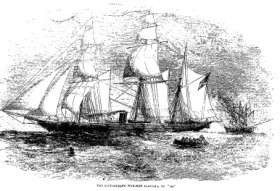
The American Civil War only features slightly, if at all, in the British collective memory, but the war years 1861–1865 saw special strains placed on relationship between the two nations. In Britain the conflict became one of the most debated topics of the day, leading to a proliferation of pamphlets, newspaper reports and letter-writing campaigns, as well as pro-Confederate balls, anti-slavery petitions and cotton boycotts.

CSS Alabama, Alias 290, Penny Illustrated Paper, 15 Nov. 1862
1862 LON 105 [1861] NPL; 19th Century British Library Newspapers
Economic ties
Even after the War of Independence and the War of 1812, there remained many commercial, social and cultural ties between Britain and the United State. The two nations were also often competitors, suspicious of one another, particularly with regard to the British northern provinces and in relation to Central and Southern America. British investment in the United States was considerable, and the cotton mills of northern Britain and Ireland relied on the Southern states for their raw materials. Industrial developments, notably the railways, were also often financed through British banks and companies. As part of the British Empire, the British North American provinces and the Caribbean formed important markets and sources of raw material.
Such considerations informed the course of the war. The Confederate states believed that British and other European reliance on their slave-plantation produced cotton would ensure early recognition for their independence, a factor that led to the announcement of the secession from the Union. As the Democratic senator for South Carolina, James Henry Hammond, threatened, 'You dare not make war on cotton. No power on earth dares to make war upon it. Cotton is king'. British mill owners, it was believed, could not risk their machines falling quiet.
British attitudes towards the North and South
Attitudes towards the North and South helped to inform British policy towards America. These views often differed according to social class and from region to region. Historians continue to debate the nature and importance of these divisions. It is usually argued that the British ruling and middle classes took the view that Southern society owed much to British aristocratic and gentlemanly manners and outlook, while the North represented industrial competition with Britain, and remained a bastion of Yankee independence, forever revelling in its overthrow of British rule in the 1770s and 1780s. Those giving their support to the Southern states feared Northern industrial competition and saw widespread democracy as a source of political breakdown and civil strife.
In contrast, radicals and the lower-middle and working classes firmly supported the democratic, anti-slavery, industrialised North. The Emancipation Proclamation of 1862 helped to galvanise support of the Union among many in Britain, confirming the war as a campaign for democracy and against slavery. The North and the black American population was also conceived in a more sympathetic light, one that drew its energy from the enormous popularity of Harriet Beecher Stowe's Uncle Tom’s Cabin: or, Life Amongst the Lowly (1852). Many thousands of copies were sold in the Britain, and the anti-slavery novel also inspired a range of songs, poems, plays and paintings.
However, these neat distinctions have increasingly been criticised by historians. The notion of northern, working-class support for the North may have been promulgated by Richard Cobden and John Bright as part of their political campaigns, rather than having being something that was widely shared. Regional studies have shown that many areas in the north of England, such as Lancashire, and particularly Liverpool, were strongly pro-Confederate. Detailed studies of the press have also revealed the importance of the issue of slavery to the British debate, notably the damage done to the Confederate case and widespread scepticism of Union anti-slavery feeling.
Britain and the World
The Civil War took place within a global context, with important strategic implications for the British Empire. Britain had recently fought in the Crimean War (1853–1856) and was reeling from the Indian Rebellion of 1857–1858. One of Britain’s main strategic aims was to avoid becoming drawn into the American conflict, while being aware of the need to defend its Canadian provinces and its strategic interest in the Caribbean and Latin America, as well as its wider role in the world.
Key Events
As well as economic ties, public opinion and strategic realities, a series of events became key flashpoints in the relationship between America and Britain.
The Trent Affair
In 1861, the USS San Jacinto, commanded by Captain Charles Wilkes, intercepted the British mail packet, RMS Trent, and captured two Confederate diplomats, James Mason and John Slidell. The Trent Affair was a diplomatic incident of the first order.
RELATED VIDEO




 The First Battle of Winchester, fought on May 25, 1862, in and around Frederick County, Virginia, and Winchester, Virginia, was a major victory in Confederate Army Maj. Gen. Thomas J. "Stonewall" Jackson's Campaign through the Shenandoah Valley during the American...
The First Battle of Winchester, fought on May 25, 1862, in and around Frederick County, Virginia, and Winchester, Virginia, was a major victory in Confederate Army Maj. Gen. Thomas J. "Stonewall" Jackson's Campaign through the Shenandoah Valley during the American...
 The First Battle of Kernstown was fought on March 23, 1862, in Frederick County and Winchester, Virginia, the opening battle of Confederate Maj. Gen. Thomas J. "Stonewall" Jackson's campaign through the Shenandoah Valley during the American Civil War.
The First Battle of Kernstown was fought on March 23, 1862, in Frederick County and Winchester, Virginia, the opening battle of Confederate Maj. Gen. Thomas J. "Stonewall" Jackson's campaign through the Shenandoah Valley during the American Civil War.







